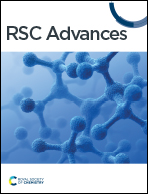Investigation of the structure and dielectric properties of doped barium titanates
Abstract
This work examined the influence of zirconium concentration on barium titanate (BZT) BaZrxTi1−xO3, with (x = 0, 0.15, 0.50, 0.75, and 1), produced by the tartrate precursor technique. The Fourier transform infrared (FTIR) spectra support the X-ray diffraction (XRD) results regarding formation of the perovskite structure. Grain size grows with Zr concentration, suggesting that the presence of Zr ions enlarges the grains. The transmission electron microscopy (TEM) images demonstrated that, due to their nano size, nanocrystallites are agglomerated in most images with irregular morphologies and average particle sizes from 20.75 nm to 63.75 nm. Increasing Zr content diminished the piezoelectric coefficient (d33) and the grain size. The value of d33 decreases by increasing Zr content, and there is an inverse relationship between grain size and d33. The remnant polarization of BZT increases with increasing Zr4+ content, which may be suitable for permanent memory device applications.



 Please wait while we load your content...
Please wait while we load your content...